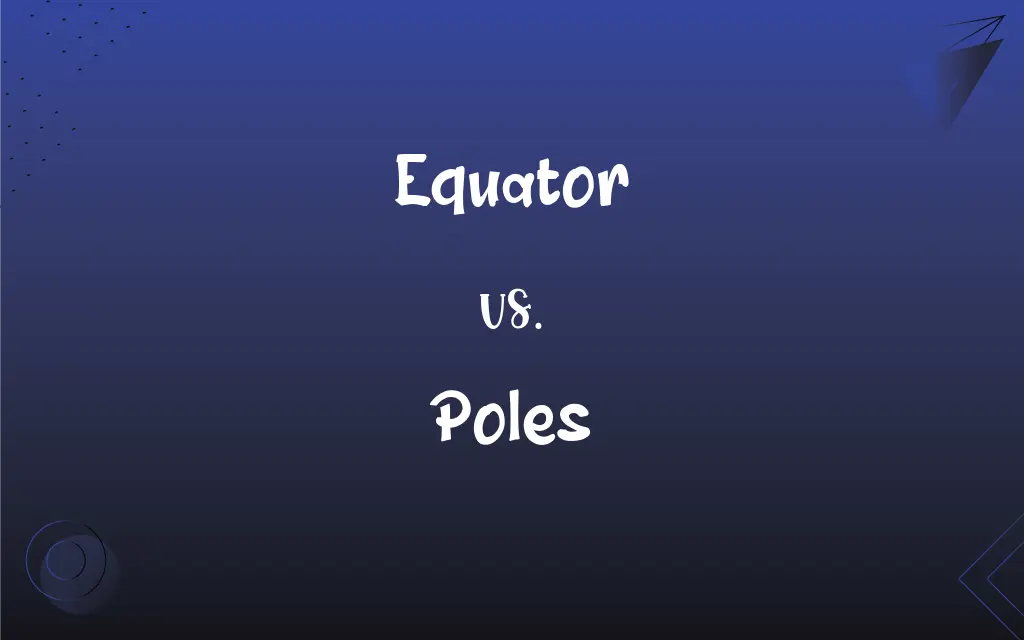Equator vs. Poles: What's the Difference?
Edited by Aimie Carlson || By Janet White || Published on February 13, 2024
The equator is an imaginary line encircling the Earth's widest part, while the poles are the two opposite points where the Earth's axis intersects its surface.

Key Differences
The equator, an imaginary line around the Earth's widest circumference, divides the planet into Northern and Southern Hemispheres. The poles, North and South, are the two extreme points of the Earth's rotational axis. This distinction highlights the contrast in Earth's geometry and orientation.
Climatically, the equator experiences consistent temperatures and daylight throughout the year due to its equidistant position from the sun. In contrast, the poles undergo extreme variations in daylight and darkness, with prolonged periods of each, influencing their respective harsh, cold climates.
Biodiversity around the equator is significantly higher, with dense rainforests and diverse ecosystems, owing to the warm, moist climate. The poles, however, have minimal flora and fauna, primarily due to the extreme cold and ice-covered landscapes.
Geographically, the equator passes through multiple countries and continents, offering a diverse cultural and geographical landscape. The poles, isolated and situated in extreme conditions, are uninhabited and largely unexplored, contributing to their mystique in geography and exploration.
In terms of global navigation and cartography, the equator serves as a fundamental reference point for measuring latitude, while the poles define the extremities of the Earth's axis, aiding in understanding Earth's rotation and its impact on global climate and day-night cycles.
ADVERTISEMENT
Comparison Chart
Location
Earth's widest point, dividing N & S Hemispheres
Earth's rotational axis points
Climate
Warm, stable temperatures year-round
Extreme cold, seasonal daylight variation
Biodiversity
High, diverse ecosystems
Minimal, adapted to extreme cold
Human Habitation
Crosses various countries, culturally diverse
Uninhabited, largely unexplored
Role in Geography
Reference for latitude, equidistant from poles
Define Earth's rotational extremities
ADVERTISEMENT
Equator and Poles Definitions
Equator
The equator experiences equal day and night throughout the year.
On the equator, the duration of daylight remains relatively constant year-round.
Poles
The poles have prolonged periods of daylight and darkness.
During the summer, the poles experience continuous daylight.
Equator
The equator is an imaginary line encircling Earth halfway between the poles.
The country of Ecuador is named after the equator, which crosses it.
Poles
The poles are the two opposite extremities of Earth's axis.
The North and South Poles are critical for understanding Earth's rotation.
Equator
The equator divides the Earth into the Northern and Southern Hemispheres.
When you cross the equator, you move from the Northern to the Southern Hemisphere.
Poles
The poles are largely uninhabited due to extreme conditions.
Few research stations exist at the poles because of the harsh environment.
Equator
The equator is the widest circumference of the Earth.
The distance around the Earth is greatest at the equator.
Poles
The poles experience the most extreme climate on Earth.
Temperatures at the poles can drop to well below freezing.
Equator
The equator is the point of zero degrees latitude.
Navigators use the equator as a starting point for measuring latitude.
Poles
The poles are key to studying Earth's climate and environmental changes.
Scientists study ice cores from the poles to understand historical climate patterns.
Equator
The imaginary great circle around the earth's surface, equidistant from the poles and perpendicular to the earth's axis of rotation. It divides the earth into the Northern Hemisphere and the Southern Hemisphere.
Poles
Either extremity of an axis through a sphere.
FAQs
Does the equator cross any continents?
Yes, the equator crosses Africa, South America, and Asia.
Where are the poles located?
The poles are located at Earth's extreme northern and southern points, where its axis intersects the surface.
What is the equator?
The equator is an imaginary line encircling Earth at its widest point, dividing it into Northern and Southern Hemispheres.
What is the climate like at the poles?
The poles have a very cold climate, with long periods of darkness in winter and continuous daylight in summer.
What kind of animals live at the poles?
Polar bears are native to the Arctic (North Pole), while penguins are found in Antarctica (South Pole).
Does the equator's position change over time?
The equator's position is relatively stable, though Earth's tilt and orbit can cause slight variations.
What challenges do researchers face at the poles?
Extreme cold, accessibility, and environmental conditions pose challenges for polar research.
Are there any countries located entirely on the equator?
No country is entirely on the equator, but several have territories that the equator crosses.
Can you see the Northern Lights from the poles?
Yes, the Northern Lights (Aurora Borealis) are often visible in polar regions.
Are the poles always covered in ice?
Yes, the poles are generally ice-covered, with variations depending on the season.
What is the significance of the poles in navigation?
The poles are crucial for understanding Earth's magnetic field and aiding in global navigation.
Are there any unique phenomena at the poles?
Phenomena like polar ice caps, midnight sun, and polar auroras are unique to polar regions.
How does the equator affect climate?
The equator has a warm, tropical climate due to consistent sunlight year-round.
Is the equator the hottest part of Earth?
Not necessarily, as other factors like altitude and currents affect temperature.
Is it possible to travel to the equator?
Yes, many countries along the equator are accessible for tourism and travel.
How do the poles affect Earth's rotation?
The poles, being the axis points of Earth's rotation, are central to understanding diurnal and seasonal cycles.
How long is a day at the equator?
Day and night are each about 12 hours long at the equator throughout the year.
What are polar nights and polar days?
Polar nights and days refer to the periods of continuous night or day experienced at the poles.
How does the equator impact global weather patterns?
The equator influences trade winds, ocean currents, and tropical rain belts.
Is the equator visible or marked on Earth?
While the equator is an imaginary line, some locations have markers or monuments denoting its path.
About Author
Written by
Janet WhiteJanet White has been an esteemed writer and blogger for Difference Wiki. Holding a Master's degree in Science and Medical Journalism from the prestigious Boston University, she has consistently demonstrated her expertise and passion for her field. When she's not immersed in her work, Janet relishes her time exercising, delving into a good book, and cherishing moments with friends and family.
Edited by
Aimie CarlsonAimie Carlson, holding a master's degree in English literature, is a fervent English language enthusiast. She lends her writing talents to Difference Wiki, a prominent website that specializes in comparisons, offering readers insightful analyses that both captivate and inform.
































































